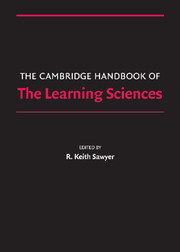Book contents
- Frontmatter
- Contents
- Preface
- Contributors
- 1 Introduction
- PART I FOUNDATIONS
- PART II METHODOLOGIES
- PART III THE NATURE OF KNOWLEDGE
- PART IV MAKING KNOWLEDGE VISIBLE
- PART V LEARNING TOGETHER
- PART VI LEARNING ENVIRONMENTS
- Afterword: After How Comes What
- Epilogue: The Fundamental Issue in the Learning Sciences
- Author Index
- Subject Index
- References
Preface
Published online by Cambridge University Press: 05 June 2012
- Frontmatter
- Contents
- Preface
- Contributors
- 1 Introduction
- PART I FOUNDATIONS
- PART II METHODOLOGIES
- PART III THE NATURE OF KNOWLEDGE
- PART IV MAKING KNOWLEDGE VISIBLE
- PART V LEARNING TOGETHER
- PART VI LEARNING ENVIRONMENTS
- Afterword: After How Comes What
- Epilogue: The Fundamental Issue in the Learning Sciences
- Author Index
- Subject Index
- References
Summary
Learning sciences is an interdisciplinary field that studies teaching and learning. Learning scientists study learning in a variety of settings, including not only the more formal learning of school classrooms but also the informal learning that takes place at home, on the job, and among peers. The goal of the learning sciences is to better understand the cognitive and social processes that result in the most effective learning, and to use this knowledge to redesign classrooms and other learning environments so that people learn more deeply and more effectively. The sciences of learning include cognitive science, educational psychology, computer science, anthropology, sociology, information sciences, neurosciences, education, design studies, instructional design, and other fields. In the late 1980s, researchers in these fields who were studying learning realized that they needed to develop new scientific approaches that went beyond what their own individual disciplines could offer, and they began to collaborate with other disciplines. Learning sciences was born in 1991, when the first international conference was held, and the Journal of the Learning Sciences was first published.
Learning sciences researchers have generated an impressive body of scholarship since 1991, and it's time to share the research with the rest of the world – education researchers, teachers, administrators, policy makers, consultants, and software designers. This handbook is your introduction to an exciting new approach to reforming education and schools, an approach that builds on the learning sciences to design new learning environments that help people learn more deeply and more effectively.
- Type
- Chapter
- Information
- The Cambridge Handbook of the Learning Sciences , pp. xi - xivPublisher: Cambridge University PressPrint publication year: 2005

